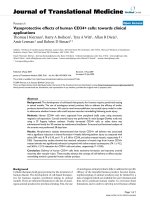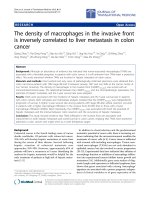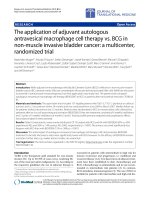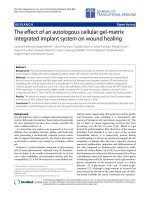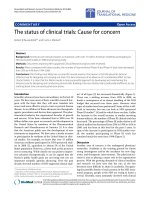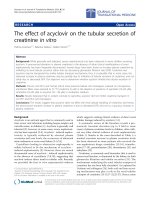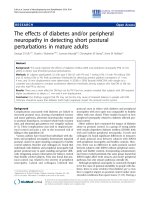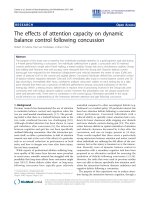Báo cáo hóa học: " The Effects of Notch Filtering on Electrically Evoked Myoelectric Signals and Associated Motor Unit Index Estimates" ppt
Bạn đang xem bản rút gọn của tài liệu. Xem và tải ngay bản đầy đủ của tài liệu tại đây (686.38 KB, 34 trang )
This Provisional PDF corresponds to the article as it appeared upon acceptance. Fully formatted
PDF and full text (HTML) versions will be made available soon.
The Effects of Notch Filtering on Electrically Evoked Myoelectric Signals and
Associated Motor Unit Index Estimates
Journal of NeuroEngineering and Rehabilitation 2011, 8:64 doi:10.1186/1743-0003-8-64
Xiaoyan Li ()
William Z Rymer ()
Guanglin Li ()
Ping Zhou ()
ISSN 1743-0003
Article type Research
Submission date 14 March 2011
Acceptance date 23 November 2011
Publication date 23 November 2011
Article URL />This peer-reviewed article was published immediately upon acceptance. It can be downloaded,
printed and distributed freely for any purposes (see copyright notice below).
Articles in JNER are listed in PubMed and archived at PubMed Central.
For information about publishing your research in JNER or any BioMed Central journal, go to
/>For information about other BioMed Central publications go to
/>Journal of NeuroEngineering
and Rehabilitation
© 2011 Li et al. ; licensee BioMed Central Ltd.
This is an open access article distributed under the terms of the Creative Commons Attribution License ( />which permits unrestricted use, distribution, and reproduction in any medium, provided the original work is properly cited.
1
The Effects of Notch Filtering on Electrically Evoked
Myoelectric Signals and Associated Motor Unit Index
Estimates
1
Xiaoyan Li,
1,2
William Z Rymer,
3
Guanglin Li,
1,2
Ping Zhou
1
Sensory Motor Performance Program, Rehabilitation Institute of Chicago, Chicago, USA
2
Department of Physical Medicine and Rehabilitation, Northwestern University, Chicago, USA
3
Research Center for Neural Engineering, Institute of Biomedical and Health Engineering,
Shenzhen Institutes of Advanced Technology, Chinese Academy of Sciences, Shenzhen, China
Correspondence should be addressed to:
Ping Zhou, Ph.D.
Sensory Motor Performance Program
Rehabilitation Institute of Chicago
345 E. Superior St, Suite 1406
Chicago, IL 60611
Email:
Phone: 312-238-1365
Email address:
XL:
WR:
GL:
PZ:
2
ABSTRACT
Background: Notch filtering is the most commonly used technique for suppression of power
line and harmonic interference that often contaminate surface electromyogram (EMG) signals.
Notch filters are routinely included in EMG recording instrumentation, and are used very often
during clinical recording sessions. The objective of this study was to quantitatively assess the
effects of notch filtering on electrically evoked myoelectric signals and on the related motor unit
index measurements.
Methods: The study was primarily based on an experimental comparison of M wave recordings
and index estimates of motor unit number and size, with the notch filter function of the EMG
machine (Sierra Wave EMG system, Cadwell Lab Inc, Kennewick, WA, USA) turned on and
off, respectively. The comparison was implemented in the first dorsal interosseous (FDI) muscle
from the dominant hand of 15 neurologically intact subjects and bilaterally in 15 hemiparetic
stroke subjects.
Results: On average, for intact subjects, the maximum M wave amplitude and the motor unit
number index (MUNIX) estimate were reduced by approximately 22% and 18%, respectively,
with application of the built-in notch filter function in the EMG machine. This trend held true
when examining the paretic and contralateral muscles of the stroke subjects. With the notch filter
on vs. off, across stroke subjects, we observed a significant decrease in both maximum M wave
amplitude and MUNIX values in the paretic muscles, as compared with the contralateral
muscles. However, similar reduction ratios were obtained for both maximum M wave amplitude
and MUNIX estimate. Across muscles of both intact and stroke subjects, it was observed that
notch filtering does not have significant effects on motor unit size index (MUSIX) estimate. No
significant difference was found in MUSIX values between the paretic and contralateral muscles
of the stroke subjects.
Conclusions: The notch filter function built in the EMG machine may significantly reduce the
M wave amplitude and the MUNIX measurement. However, the notch filtering does not
jeopardize the evaluation of the reduction ratio in maximum M wave amplitude and MUNIX
estimate of the paretic muscles of stroke subjects when compared with the contralateral muscles.
3
INTRODUCTION
Surface electromyogram (EMG) recordings are used for assessing overall muscle activity
in various disease states. The noninvasive nature and easy-to-use features of the surface
recording technique contribute to its widespread application in various fields such as
biofeedback, movement analysis, physical rehabilitation, ergonomics, occupational and sports
medicine [1]. The value of surface EMG recording for the quantification of both voluntary and
electrically elicited contractions has been demonstrated by many investigators.
It is not uncommon that during the recording process, the quality of EMG signals is
compromised by interfering noise originating from the power line and other sources. The
subsequent distortion of the surface EMG signal and the removal of the power line and other
interference have received considerable attention [2-7]. Different methods have been developed
for power line and harmonic noise suppression including the most commonly used multiple
notch filters centered on the power line and harmonic frequencies [5, 7]. Other forms of time
domain and frequency domain filters (e.g., a matched filter and a frequency domain Hampel
filter) have also been implemented for this purpose [2, 4]. Since the frequency of the interfering
signal falls within the bandwidth of the surface EMG signal, adaptive filtering has also been
developed to reject the unwanted noise while leaving the surface EMG signal relatively intact [7-
8]
.
It is worth noting that virtually all previous EMG studies that focused on assessing and
suppressing power line and harmonic noise targeted voluntary surface EMG signals, while little
attention has been given towards electrically elicited signals. Electrically evoked EMG or M
wave recordings have many important applications in both neurophysiological research and
4
clinical electrodiagnosis. For example, the ratio of the maximum peak-peak amplitude of the H-
reflex to the M wave can be considered as an index of excitability of the H-reflex arc [9-10]. Due
to the deterministic nature and the small variance of the signal, M wave recording is also
considered as a potentially preferable approach to voluntary surface EMG methods for assessing
muscle fatigability [11-12]. Visual inspection and computer aided quantification of
morphological features of the M wave can also be used to explore the physiological properties of
a muscle and their alterations in pathological states [13-15]. M wave recording is also a critical
source of information regarding potential motoneuron loss and for tracking motoneuron disease
progression. It forms the basis of various motor unit number estimation (MUNE) techniques
[16-17], or for measures using the recently developed index techniques that solely require several
maximum electrical stimulations [18-20].
The methodologies described above are based on the assumption that it is possible to
make reliable measurements of the M wave. The artifacts in the voluntary surface EMG signals
also routine exist in the electrically evoked myoelectric signals. The electrical stimulation may
impose extra artifacts in the recorded EMG signal. Moreover, M wave or compound muscle
action potential (CMAP) is often used as a diagnostic tool in a clinical environment, where
electrical power supplies are prevalent. Thus, the surface EMG electrode may inevitably pick up
electromagnetic noise [3]. In such a situation, suppression of power line and harmonic
interference is required to have uncontaminated M wave recordings. In fact, most of the clinical
EMG machines have a built-in-notch filtering function, optional to operators. Given the above,
there are surprisingly no studies to our knowledge that have investigated the effects of imposing
such a noise reduction processing on the M wave and other related measures and calculations.
Most of the previous studies have focused on simple test-retest reliability, including two studies
5
performing comprehensive analysis of M wave reliability using the intraclass correlation
coefficients [11, 15, 21]. During our previous studies [22], we noted that the maximum M wave
amplitude of our subjects tended to be low compared with the values reported by others [23-24],
potentially due to the application of the system notch filtering function in the EMG machine.
However, the quantitative analyses of the effects of notch filtering on M wave and other related
measurements are lacking.
In light of this deficiency, the purpose of our study was to examine how the most
commonly used notch filter for power line interference suppression could influence M wave
recordings. The amplitude, or the area of the negative phase of the M wave, plays a critical part
in estimating the motor unit numbers in a muscle [16-17]. We thus chose to examine the
influence of notch filtering on these parameters. We also explored how the notch filter could
change the motor unit number index (MUNIX) estimate, a recently developed
neurophysiological technique that relies on maximum M wave and voluntary surface EMG
signals for computing an index proportional to the number of motor units in a muscle [19-20].
Finally, to investigate the effects of notch filtering on assessment of muscle fiber or motor unit
loss, we compared the findings in the presence and absence of the notch filter functions when
using M wave and MUNIX measurements to examine the paretic and contralateral muscles of
stroke survivors.
6
METHODS
A. Subjects
Fifteen neurologically intact subjects (9 males, 6 females, 41.5 ± 13.7 years) and 15
subjects (8 males, 7 females, 59.2 ± 11.2 years) who sustained hemiparetic stroke participated in
this study. All our stroke subjects were recruited from the Clinical Neuroscience Research
Registry at the Rehabilitation Institute of Chicago (Chicago, IL, USA). A screening examination
and clinical assessment were performed by a physical therapist to determine the eligibility for
each stroke subject. Inclusion criteria for participation of the study include age between 21-75
years old; experience of stroke with initial onset more than 6 month; medically stable with
clearance to participate; ability to provide informed consent, with Mini‐Mental State
Examination (MMSE) must be 23 or higher. Exclusion criteria include history of spinal cord
injury or traumatic brain damage; inability to comprehend conversations; history of serious
medical illness such as cardiovascular or pulmonary complications; history of severe motion
sickness; and any condition that, in the judgment of a physician, would prevent the person from
participating. Women who are pregnant or nursing were excluded from the study. Among the 15
stroke subjects, the left limb was affected in 7 subjects and the right limb was affected in 8
subjects. The duration between the stroke onset and the experiment time was 11.7 ± 7.5 years
(range: from 10 months to 24 years and 6 months). The 15 stroke subjects showed a Chedoke
score of 3 ± 1, and a Fugl-Meyer (hand) score of 7 ± 5. The study was approved by the
Institutional Review Board of Northwestern University (Chicago, IL, USA). All subjects gave
their written consent before the experiment.
7
B. Experiments
Experiments were performed on the first dorsal interosseous (FDI) muscle of the
dominant hand of the neurologically intact subjects, and bilaterally in all the hemiparetic stroke
subjects. Subjects were seated comfortably in a chair with the examined forearm placed in its
natural, resting position on a height-adjustable table. They were instructed to relax at the wrist,
elbow and shoulder. The hand and forearm were held in a vertical half supinated position. Hand
skin temperature was not specifically monitored during the experiment. A thermometer showed a
constant temperature (approximately 72 degrees Fahrenheit) in the laboratory.
Prior to the recording, the skin surfaces over the ulnar aspect of the wrist, the back of the
hand, and the index finger were lightly abraded and cleaned with rubbing alcohol to facilitate the
recording. A small amount of conductive electrode cream was used to reduce skin-electrode
impedance. Care was taken not to leave any on the skin to avoid short-circuiting the electrodes.
The maximum M wave or CMAP was recorded first. Evoking the maximum M wave by
supramaximal stimulation is the electrical equivalent of recruiting of all motor units within a
muscle innervated by the stimulated nerve. A maximum M wave from the FDI muscle was
obtained by stimulation of the ulnar nerve at the wrist, using an intensity sufficient to elicit a
maximum CMAP. The primary equipment used for this recording was the Sierra Wave EMG
system (Cadwell Lab Inc, Kennewick, WA, USA). A remote handheld stimulator with a
StimTroller was used to generate stimuli through a cathode (a 10 mm silver/silver chloride pole).
Two 10 mm silver/silver chloride disc surface recording electrodes were used to record
electrical activity from the FDI muscles. Electrode placement was similar to that for standard
ulnar motor studies. The active surface electrode was positioned over the motor point of the FDI
muscle with the reference surface electrode positioned over the second metacarpophalangeal
8
(MCP) joint. An adhesive ground electrode was placed on the back of the hand. All the surface
electrode positions were further reinforced with surgical tape to reduce electrode movement
during the recording.
The ulnar nerve was stimulated about 2 cm proximal to the wrist crease. The duration of
each stimulus was 200 ms. Different from the stimulus protocol used for traditional MUNE
methods (where the stimulus intensity usually starts below the response threshold and increases
in very small increments until the maximum M wave is achieved), in our MUNIX study the
stimulation intensity started around 15-20 mA. The intensity was further increased in increments
of approximately 20% above that until the stimulation intensity eliciting the maximal response
was reached. Then, the stimulation intensity was increased to 120% of the final intensity to
confirm that no further increase in the peak-to-peak amplitude of the M wave. Such a use of
approximately 20 percent supramaximal stimulation intensity guarantees the activation of all the
motor axons innervating the muscle. Previous studies demonstrated low CMAP amplitudes from
suboptimal electrode placement (or nerve stimulation) may yield erroneously low MUNIX
values [18]. Therefore, to ensure that the CMAP amplitude is maximized throughout the MUNIX
study, during the experiment, the electrode placement was optimized by testing several different
locations. In addition, re-cleaning of the skin and reapplication of the electrode cream were
performed as necessary (to guarantee the best recording quality).
With all the electrodes maintained at the same position, after the maximum M wave
recording, voluntary surface EMG signals were recorded from the FDI muscle while the subject
generated an isometric muscle contraction force at 5-10 different levels (representing minimal to
maximal effort). The force levels were defined qualitatively by the examiner, offering resistance
in abduction to the contracting FDI muscle. The different force levels were recorded using a
9
single trial with graded contractions consisting of the required EMG epochs distributed from
minimal to maximal effort. Subjects were allowed substantial rest to avoid muscle fatigue during
the recording.
For all subjects, the M waves and voluntary surface EMG responses were sampled at
2000 Hz. To investigate the effects of notch filtering on M wave recording and other related
calculations, the maximum M wave was recorded with the built-in-notch filter (1
st
order filter,
rejected frequency 60 Hz) function of the EMG machine on, and repeated with the notch filter
off. The notch filter was turned off for voluntary surface EMG recordings. Responses recorded
by the electrodes were amplified by a differential AC amplifier. A split screen sensitivity was set
at 2mV/division in the M wave zone. Sweep speed was 5ms/division. All signals were recorded
to a hard disk and analyzed offline.
C. Data Analysis
The maximum M wave and different levels of voluntary surface interference pattern
(SIP) EMG were used to compute the MUNIX for the examined FDI muscle [19-20]. The area
and power of the maximum M wave were first computed. Then, the voluntary surface EMG
signals were examined, and those SIPs with high frequency noise, power line interference,
baseline shift or other artifacts were excluded from the analysis. The remaining SIP signals were
used to calculate the average area and power of the SIP for a one-second epoch. This analysis
was performed for each voluntary contraction level. The values calculated from the maximum M
wave and different levels of SIPs were used to compute the “ideal case motor unit count
(ICMUC)”:
(1)
10
Thus, each level of SIP gave two results: SIP area and ICMUC. Regression analysis was
then used to define the relationship between SIP area and ICMUC by the following formula:
(2)
The parameters β and α obtained from the regression were used to compute the MUNIX
[19-20]:
(3)
In MUNIX analysis, it should be noted that very low amplitude voluntary surface EMG
signals can give very high ICMUC values. To exclude this artifact, three criteria were imposed to
accept an SIP epoch [18]: (1) SIP area> 20mVms; (2) ICMUC<100; and (3) SIP area/CMAP
area>1.
With MUNIX values available, the motor unit size index (MUSIX) could be obtained by
dividing MUNIX into the maximum M wave amplitude [18]:
(4)
MUSIX, measured in volts, is an index that reflects the average amplitude of the
individual surface motor unit action potentials (MUAPs).
We measured the maximum M wave amplitude, the MUNIX and MUSIX values in the
dominant FDI muscles of neurologically intact subjects and bilaterally in hemiparetic stroke
subjects, with the notch filtering function turned on and off for M wave recordings respectively.
We determined whether the notch filtering function has significant effects on M wave recording
and motor unit index measurement. We specifically examined how such a filtering function may
11
affect our evaluation of muscle fiber or motor unit loss in paretic muscles by comparing the
measured parameters with the contralateral muscles, in the presence and absence of the notch
filtering function. The analysis of variance (ANOVA) was used for statistical analysis. The
significance level was defined as p < 0.05.
12
RESULTS
Results from neurologically intact subjects
Recording of maximum M waves and voluntary surface EMG signals at different levels
of contraction were obtained from dominant hand FDI muscles of all the intact subjects with or
without the notch filtering function turned on. For all the intact subjects, we observed a
significant decrease in maximum M wave amplitude when notch filter was on, as compared with
observations made with the filter off (Figure 1). As Figure 1a illustrates, in addition to reduced
amplitude and area of the first negative phase of the M wave, the M wave shape tends to change
from two major phases to multiple phases. Across all intact subjects (Figure 1b), the maximum
M wave amplitude of the FDI muscle was 10.8±2.1 mV (range: 6.2-13.8 mV) for notch filtering
on and 13.9±2.4 mV (range: 8.4-16.7 mV) for notch filtering off (p<0.001).
Maximum M wave recordings, in combination with voluntary surface EMG at different
muscle contraction levels, were used to derive the MUNIX measurements. Figure 2a
demonstrates an example of the MUNIX calculation, where the maximum M wave was recorded
with presence and absence of the notch filtering function (10.0 mV and 13.7 mV, respectively).
Analysis of SIP measurements from minimal to maximum voluntary muscle contraction in
different steps (the individual data points in Figure 2a) shows an excellent fit with the
mathematical model used to calculate the MUNIX (lines representing Equation 2). This subject
showed a MUNIX value of 234 for the notch filtering on, which was lower than the MUNIX
value of 279 for the notching filtering off.
13
Across all subjects (Figure 2b), the MUNIX value was 182±51 (range: 67-243) for notch
filtering on and 222±58 (range: 91-300) for notch filtering off (p<0.001). MUSIX values of FDI
muscles were obtained from maximum M wave and MUNIX calculation according to Equation
4.
Across all subjects (Figure 2c), the MUSIX value was 55.7±8.6 µV (range: 43.2-68.6 µV) for
notch filtering on and 55.8±7.7 µV (range: 44.2-67.6 µV) for notch filtering off (p>0.4).
Results from stroke subjects
Recordings of maximum M waves and voluntary surface EMG signals at different levels
of contraction were also obtained from paretic and contralateral FDI muscles of all our stroke
subjects, with and without the notch filter implemented.
Figure 3 demonstrates a comparison of the MUNIX calculation from paretic and
contralateral muscles of one stroke subject, with notch filtering function on and off. For this
stroke subject, the maximum M wave was 7.4 mV (notch filter on) and 8.9 mV (notch filter off)
for the paretic muscle, compared with 12.3 mV (notch filter on) and 15.2 mV (notch filter off)
for the contralateral muscle. It is worth noting that the maximum voluntary surface EMG level
generated by the paretic muscle was also much lower than that from the contralateral muscle, as
indicated by the x-axis values of the individual data points used for the curve fitting. With the
measured maximum M wave and different levels of voluntary surface EMG values, this stroke
subject showed a MUNIX value of 113 (notch filter on) and 130 (notch filter off) for the paretic
FDI muscle, much lower than the MUNIX value of 221 (notch filter on) and 273 (notch filter
off) for the contralateral muscle. In combination with the maximum M wave amplitudes, this
14
resulted in MUSIX values of 65.5 µV (notch filter on) and 68.5 µV (notch filter off) for the
paretic muscle, and 55.7 µV (notch filter on or off) for the contralateral muscle.
Figure 4 shows the effects of adding notch filtering on the maximum M wave amplitude
for paretic and contralateral muscles across all stroke subjects. The maximum M wave amplitude
was significantly reduced by the notch filtering for both muscles. As Figure 4a indicates, across
paretic muscles, the maximum M wave amplitude was 7.8±1.9 mV (range: 3.9-10.2 mV) for
notch filtering on and 9.9±2.5 mV (range: 5.0-13.8 mV) for notch filtering off (p<0.001); across
contralateral muscles, the maximum M wave amplitude was 9.7±1.7 mV (range: 6.2-12.3 mV)
for notch filtering on and 13.0±2.2 mV (range: 9.8-16.2 mV) for notch filtering off (p<0.001).
Figure 4b shows the ratio of the maximum M wave amplitude in the presence and absence of the
notch filtering, respectively, when the paretic muscles were compared with the contralateral ones
(i.e. maximum M wave of paretic muscles divided by maximum M wave of contralateral
muscles). It was observed that notch filtering does not have significant effects on the paretic-
contralateral M wave ratio.
For all the stroke subjects, exponential regression analysis in Equation 2 showed a good
fitting for the relationship between SIP area and ICMUC. Figure 5 shows the effects of notch
filtering on the MUNIX for paretic and contralateral muscles across all stroke subjects. Similar
to findings in maximum M wave amplitude, the MUNIX was significantly decreased by the
notch filtering for both muscles. Across paretic muscles, the MUNIX was 126±35 (range: 56-
179) for notch filtering on and 158±49 (range: 74-264) for notch filtering off (p<0.001); across
contralateral muscles, the MUNIX was 158±35 (range: 92-221) for notch filtering on and
204±47 (range: 113-273) for notch filtering off (p<0.001) (Figure 5a). Figure 5b shows the
MUNIX ratio in the presence and absence of the notch filtering, respectively, when the paretic
15
muscles were compared with the contralateral ones (i.e. MUNIX of paretic muscles divided by
MUNIX of contralateral muscles). It was observed that notch filtering does not have significant
effects on the paretic-contralateral MUNIX ratio.
In contradistinction to our observations on maximum M wave amplitude and MUNIX
measurements across all our stroke subjects, we did not observe a significant influence of notch
filtering on MUSIX values. As we illustrate in Figure 6, drawn from paretic muscles of stroke
subjects, the MUSIX was 62.9±8.9 µV (range: 51.9- 82.7 µV) with notch filtering on and
63.9±9.9 µV (range: 49.8-84.8 µV) with notch filtering off (p>0.2). For contralateral muscles,
the MUSIX was 64.3±10.5 µV (range: 47.8-84.8 µV) for notch filtering on and 64.6±10.3 µV
(range: 49.1-84.6 µV) for notch filtering off (p>0.8). It is worth noting that with notch filtering
on or off, MUSIX values did not show significant differences between paretic and contralateral
muscles (p>0.5).
16
DISCUSSION
Technical note
Considering that power line and harmonic noise are common during EMG recording,
especially in a clinical environment with many medical or electrical supplies nearby, notch
filtering is very often, if not routinely, used to suppress electromagnetic noise thus increasing the
signal to noise ratio. Although earlier studies have investigated the influence of notch filtering
and other electromagnetic noise suppression methods on EMG recording and other related
measurements for voluntary muscle contractions [2-7], it remains unclear how such processing
may alter the M wave parameters or related calculations. The present study used an experimental
approach and performed a systematic examination of notch filtering effects on M wave and other
relevant calculations. Our study shows that with the specific notch filter function of the EMG
machine (Sierra Wave EMG system, Cadwell Lab Inc, Kennewick, WA, USA), on average the
notch filtering can reduce up to more than 20% of the M wave amplitude. This could induce an
average decrease in MUNIX measurement by approximately 18%. On the other hand, the notch
filtering does not have significant effects on MUSIX measurement. In a previous study [22], we
found relatively lower maximum M wave amplitudes for the FDI muscles when comparing with
the reported values by other studies [23-24]. The findings from the present study confirm that the
notch filtering processing takes a significant part in generating such a difference, although some
other factors (such as subject ages) may also contribute.
It is noteworthy that the suppression of the electromagnetic noise during
electrodiagnostic examination can usually be realized by online selection of the notch filtering
17
function built into the EMG machine during the experiment while different EMG machines may
have different notch filtering implementations. The findings in this report were from the analyses
of the data collected using the specific EMG machine (Sierra Wave EMG system, Cadwell Lab
Inc, Kennewick, WA, USA), where a 1
st
order notch filter was implemented at the rejection
frequency of 60 Hz. A different EMG machine may result in different ratios of reduction in
maximum M wave amplitude and MUNIX values, in that the notch filter function may be
implemented in various approaches. For example, more distortions in M wave may be imposed if
the notch filter involves multiple rejecting frequencies (i.e. harmonic frequencies such as 120 Hz,
180 Hz and so on). On the other hand, the relatively significant waveform distortion shown in
this study (Figure 1) may be from the low order (1
st
order) implementation of the notch filter
function. Increasing the orders of the filter may reduce the distortion imposed on the M wave.
Implication for application of the MUNIX measurement
This study also investigated the effects of notch filtering on assessment of muscle fiber or
motor unit loss in paretic muscles of stroke survivors, using maximum M wave recording and
MUNIX calculation. The maximum M wave amplitude provides a reasonable approximation of
the total number of muscle fibers in a muscle (or the number of motor units if the average motor
unit size remained unchanged after stroke), while MUNIX measurement provides an index of the
motor unit numbers in the muscle. Compared with the traditional MUNE methods that involve
estimates of single motor unit potential size using either incremental nerve stimulation or spike
triggered averaging techniques (both potentially laborious and time-consuming), the most
advantage of the MUNIX measurement does not lie in the improved performance for adequate
estimation of motor unit numbers. Instead, the most advantage of the technique is that it requires
18
minimum amounts of electrical stimulation and is convenient and quick to implement. After its
development, the technique has been successfully used to detect motoneuron loss and measure
disease progression in amyotrophic lateral sclerosis and other related neuromuscular diseases
[18, 22, 25-30]. In some patients with neurologic disorders or motoneuron diseases, the ability
in activating motor unit pool may be impaired, thus constraining the voluntary EMG generation
[31-33]. Considering that the MUNIX model relies on different levels of voluntary surface EMG
signals, three criteria were usually imposed to accept a segment of voluntary EMG as a valid SIP
epoch for MUNIX calculation, which can effectively reduce the artifacts in MUNIX estimation
induced by the very low amplitude voluntary surface EMG signals [18].
As previous MUNIX studies have pointed out [19-20], the MUNIX computation is not a
direct estimation of the motor unit number, and therefore, its values may not match the actual
motor unit numbers estimated using other more classical MUNE methods [16-17]. When
MUNIX methods are used, it should be emphasized that the objective of the study is to compare
the MUNIX changes in different muscles (e.g., in neurologically intact and disease state
muscles), or to compare the MUNIX changes in the same muscles in a longitudinal study (such
as tracking progress of a motoneuron disease). For example, the emphasis in MUNIX
examination of stroke survivors was to assess the degree of motor unit loss in the paretic muscles
when compared with the contralateral ones. With the same definition for all parameters
throughout the study, the absolute values of MUNIX are not important, in contrast to the changes
seen from two different sides of the stroke subjects.
When examining the potential effects of notch filtering on the MUNIX measurement, our
results showed that application of the notch filter function in our EMG machine (Sierra Wave
EMG system, Cadwell Lab Inc, Kennewick, WA, USA) reduced the maximum M wave
19
amplitude and the absolute values of MUNIX for all the examined muscles. On the other hand,
the notch filter function on and off resulted in similar reduction ratios of both M wave and
MUNIX measurements when paretic and contralateral muscles in stroke subjects were compared.
This implies that notch filtering has similar effects on paretic and contralateral muscles of stroke
survivors and may not alter the evaluation of the muscle fiber or motor unit loss in the paretic
muscles when compared with the contralateral muscles. This also suggests that when using
MUNIX, it is very important to keep the notch filtering settings the same (in the same EMG
machine) throughout the study to obtain reliable physiological or diagnostic information.
Spinal motoneuron involvement after a brain lesion
Although this study was oriented towards examining the effects of notch filtering on M
wave and other related motor unit index measurements, the findings also provide evidence
supporting the concept of motoneuron degeneration after a brain lesion. Previous studies have
provided conflicting information as to whether muscle weakness and other functional/anatomical
changes associated with stroke involve injury of spinal motoneurons. For example, using
different EMG techniques (e.g., concentric needle EMG, single fiber EMG, macro-EMG and
conventional surface EMG), some investigators have reported the presence of
electrophysiological abnormalities as evidence of spinal motoneuron involvement, while others
have not made such findings [34-36]. The abnormal EMG findings from paretic muscles of
stroke survivors include fibrillation and positive sharp waves [37-40], spontaneous motor unit
activities [41], increased MUAP size and complexity [39, 42], increased muscle fiber density
[39, 43], disorganization of motor unit control properties (i.e., recruitment and firing rate) [32],
and increased slope of surface EMG-force relation [44-45]. In addition, although no significant
20
difference was found in morphometric anterior horn cell numbers of the affected and unaffected
sides in stroke [46-47], variable levels of functional motor unit number reduction on the
hemiparetic side was reported in stroke patients, as revealed by several MUNE methods based on
incremental stimulation techniques [48-51]. Consistent to previous findings [52-53], this study
shows a significant reduction in the maximum M wave amplitude in the paretic muscles
compared with the contralateral or neurologically intact muscles. The MUNIX values were also
found to be significantly lower in paretic muscles of stroke survivors. No significant difference
in the MUSIX values was found between paretic and contralateral muscles. One potential
explanation for lack of difference in MUSIX is that the paretic muscles may experience several
pathological changes, for example, atrophy or denervation of muscle fibers and the reinnervtaion
of muscle fibers as a compensatory process after motoneuron degeneration. Muscle fiber atrophy
or dennervation may result in decreased MUSIX values while muscle fiber reinnervation may
result in increased MUSIX values. Thus, the mean MUSIX values may not change dramatically
when compared with the contralateral muscles.
The findings from motor unit index analysis provide further electrophysiological
evidence of spinal motoneuron involvement following a stroke, suggesting that M wave and
motor unit index measurements in stroke have important clinical value for the diagnosis of
chronic stroke, the improvement of outcome measurements, and evaluation of the effects of
medication or therapies.
21
CONCLUSIONS
This study quantitatively assessed the effects of notch filtering on electrically evoked
myoelectric signals and the related motor unit index measurements. The study was primarily
based on an experimental comparison with the built-in notch filter function of the EMG machine
(Sierra Wave EMG system, Cadwell Lab Inc, Kennewick, WA, USA) turned on and off,
respectively. On average, for intact subjects, the M wave amplitude and MUNIX value of the
FDI muscles were reduced by approximately 22% and 18%, respectively, with application of the
notch filter function of the EMG machine. This trend held true when examining the paretic and
contralateral muscles of stroke subjects. With the notch filter on vs. off, across stroke subjects,
we observed a significant decrease in both maximum M wave amplitude and MUNIX values in
the paretic FDI muscles, as compared with the contralateral muscles. However, similar reduction
ratios were obtained for both M wave amplitude and MUNIX values. Across muscles of both
intact and stroke subjects, it was observed that notch filtering does not have significant effects on
MUSIX measurement. No significant difference was found in MUSIX values between the
paretic and contralateral muscles of stroke subjects.
22
COMPETING INTERESTS
The authors declare that they have no competing interests.
AUTHOR’S CONTRIBUTIONS
XL performed human subject recruitment, experiment design, data collection and
analysis, interpretation of the results, and drafting of the manuscript. WR was involved in
interpretation of the results and revision of the manuscript. GL was involved in interpretation of
the results. PZ oversaw the study and was involved in every stage of the study, including critical
revision of the manuscript. All authors read and approved the final manuscript.
ACKNOWLEDGEMENTS
This study was supported by the Brinson Stroke Foundation, the Davee Research
Foundation, the National Institute on Disability and Rehabilitation Research of the United States
Educational Department (Grants H133G090093, H133F110033), the National Institutes of
Health (Grant 2R24HD050821-06), and the National Natural Science Foundation of China
(Grant 60971076). The authors thank Sanjeev Nandedkar, PhD and Paul Barkhaus, MD for
many useful discussions during the performance of this study.
23
REFERENCES
1. Merletti R and Parker PA: Introduction, in Electromyography: physiology, engineering,
and noninvasive applications Hoboken, New Jersey: John Wiley & Sons, Inc.; 2004.
2. Allen DP: A frequency domain Hampel filter for blind rejection of sinusoidal
interference from electromyograms. J Neurosci Methods 2009, 177:303-310.
3. Aschero G and Gizdulich P: Denoising of surface EMG with a modified Wiener
filtering approach. J Electromyogr Kinesiol 2010, 20:366-373.
4. Baratta RV, Solomonow M, Zhou BH, and Zhu M: Methods to reduce the variability
of EMG power spectrum estimates. J Electromyogr Kinesiol 1998, 8:279-285.
5. Mello RG, Oliveira LF, and Nadal J: Digital Butterworth filter for subtracting noise
from low magnitude surface electromyogram. Comput Methods Programs Biomed
2007, 87:28-35.
6. Mewett DT, Reynolds KJ, and Nazeran H: Reducing power line interference in
digitised electromyogram recordings by spectrum interpolation. Med Biol Eng
Comput 2004, 42:524-531.
7. Beck TW, DeFreitas JM, Cramer JT, and Stout JR: A comparison of adaptive and
notch filtering for removing electromagnetic noise from monopolar surface
electromyographic signals. Physiol Meas 2009, 30:353-361.
8. Clancy EA, Bouchard S, and Rancourt D: Estimation and application of EMG
amplitude during dynamic contractions. IEEE Eng Med Biol Mag 2001, 20:47-54.
9. Crone C, Johnsen LL, Hultborn H, and Orsnes GB: Amplitude of the maximum motor
response (Mmax) in human muscles typically decreases during the course of an
experiment. Exp Brain Res 1999, 124:265-270.
10. Maffiuletti NA, Martin A, Babault N, Pensini M, Lucas B, and Schieppati M: Electrical
and mechanical H(max)-to-M(max) ratio in power- and endurance-trained athletes.
J Appl Physiol 2001, 90:3-9.
11. Merletti R, Fiorito A, Lo Conte LR, and Cisari C: Repeatability of electrically evoked
EMG signals in the human vastus medialis muscle. Muscle Nerve 1998, 21:184-193.
12. Merletti R, Knaflitz M, and DeLuca CJ: Electrically evoked myoelectric signals. Crit
Rev Biomed Eng 1992, 19:293-340.
13. Lo Conte LR and Merletti R: Advances in processing of surface myoelectric signals:
Part 2. Med Biol Eng Comput 1995, 33:373-384.
14. Lo Conte LR, Merletti R, and Sandri GV: Hermite expansions of compact support
waveforms: applications to myoelectric signals. IEEE Trans Biomed Eng 1994,
41:1147-1159.
15. Merletti R and Lo Conte LR: Advances in processing of surface myoelectric signals:
Part 1. Med Biol Eng Comput 1995, 33:362-372.
16. Bromberg MB: Updating motor unit number estimation (MUNE). Clin Neurophysiol
2007, 118:1-8.
17. McComas AJ, Fawcett PR, Campbell MJ, and Sica RE: Electrophysiological estimation
of the number of motor units within a human muscle. J Neurol Neurosurg Psychiatry
1971, 34:121-131.
18. Nandedkar SD, Barkhaus PE, and Stalberg EV: Motor unit number index (MUNIX):
principle, method, and findings in healthy subjects and in patients with motor
neuron disease. Muscle Nerve 2010, 42:798-807.
24
19. Nandedkar SD, Nandedkar DS, Barkhaus PE, and Stalberg EV: Motor unit number
index (MUNIX): a pilot study, in Motor Unit Number Estimation, M. B. Bromberg, ed.,
Supplements to Clinical Neurophysiology, vol. 55. New York: Elsevier Science B.V.,
2003, pp. 133–140.
20. Nandedkar SD, Nandedkar DS, Barkhaus PE, and Stalberg EV: Motor unit number
index (MUNIX). IEEE Trans Biomed Eng 2004, 51:2209-2211.
21. Calder KM, Hall LA, Lester SM, Inglis JG, and Gabriel DA: Reliability of the biceps
brachii M-wave. J Neuroeng Rehabil 2005, 2:33.
22. Li X, Wang YC, Suresh NL, Rymer WZ, and Zhou P: Motor unit number reductions
in paretic muscles of stroke survivors. IEEE Trans Inf Technol Biomed 2011, 15:505-
512.
23. Boe SG, Stashuk DW, Brown WF, and Doherty TJ: Decomposition-based quantitative
electromyography: effect of force on motor unit potentials and motor unit number
estimates. Muscle Nerve 2005, 31:365-373.
24. Boe SG, Stashuk DW, and Doherty TJ: Within-subject reliability of motor unit
number estimates and quantitative motor unit analysis in a distal and proximal
upper limb muscle. Clin Neurophysiol 2006, 117:596-603.
25. Ahn SW, Kim SH, Kim JE, Kim SM, Kim SH, Park KS, Sung JJ, Lee KW, Hong YH:
Reproducibility of the motor unit number index (MUNIX) in normal controls and
amyotrophic lateral sclerosis patients. Muscle Nerve 2010, 42:808-813.
26. Neuwirth C, Nandedkar S, Stalberg E, and Weber M: Motor unit number index
(MUNIX): a novel neurophysiological technique to follow disease progression in
amyotrophic lateral sclerosis. Muscle Nerve 2010, 42:379-384.
27. Sandberg A, Nandedkar SD, Stålberg E: Macro electromyography and motor unit
number index in the tibialis anterior muscle: differences and similarities in
characterizing motor unit properties in prior polio. Muscle Nerve 2011, 43: 335-341.
28. Nandedkar SD, Barkhaus PE, Stålberg EV: Reproducibility of MUNIX in patients with
amyotrophic lateral sclerosis. Muscle Nerve 2011, 44:919-922.
29. Neuwirth C, Nandedkar S, Stålberg E, Barkhaus PE, Carvalho M, Furtula J, Dijk JP,
Baldinger R, Castro J, Costa J, Otto M, Sandberg A, Weber M: Motor Unit Number
Index (MUNIX): a novel neurophysiological marker for neuromuscular disorders;
test-retest reliability in healthy volunteers. Clin Neurophysiol. 2011, 122: 1867-1872.
30. Neuwirth C, Nandedkar S, Stålberg E, Barkhaus PE, Carvalho M, Furtula J, van Dijk JP,
Baldinger R, Castro J, Costa J, Otto M, Sandberg A, Weber M: Motor Unit Number
Index (MUNIX): reference values of five different muscles in healthy subjects from
a multi-centre study. Clin Neurophysiol. 2011, 122:1895-1898.
31. Kent-Braun JA, Walker CH, Weiner MW, and Miller RG: Functional significance of
upper and lower motor neuron impairment in amyotrophic lateral sclerosis. Muscle
Nerve 1998, 21:762-768.
32. Gemperline JJ, Allen S, Walk D, and Rymer WZ: Characteristics of motor unit
discharge in subjects with hemiparesis. Muscle Nerve 1995, 18:1101-1114.
33. Zijdewind I and Thomas CK: Motor unit firing during and after voluntary
contractions of human thenar muscles weakened by spinal cord injury. J
Neurophysiol 2003, 89:2065-2071.

